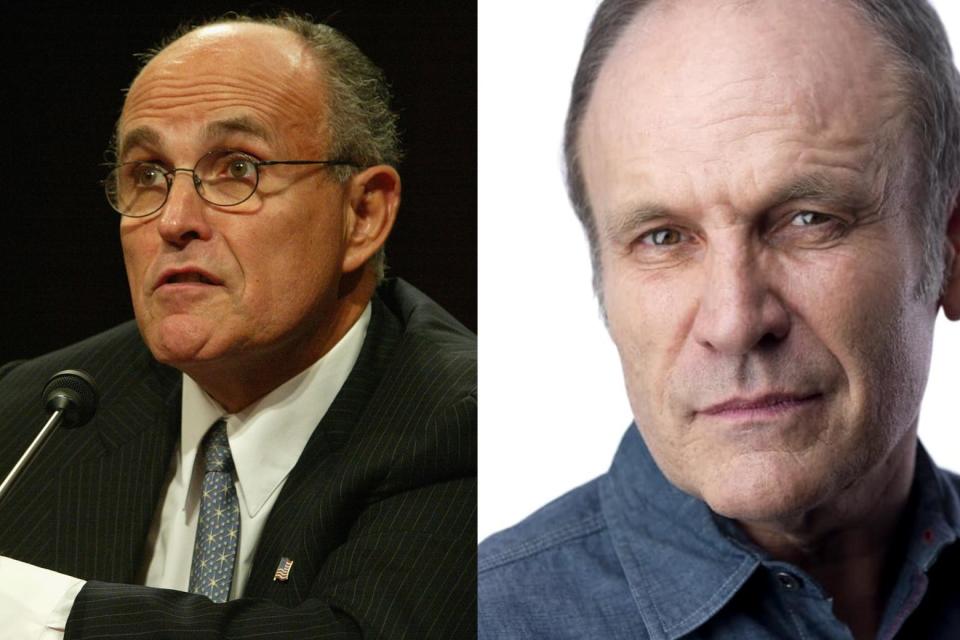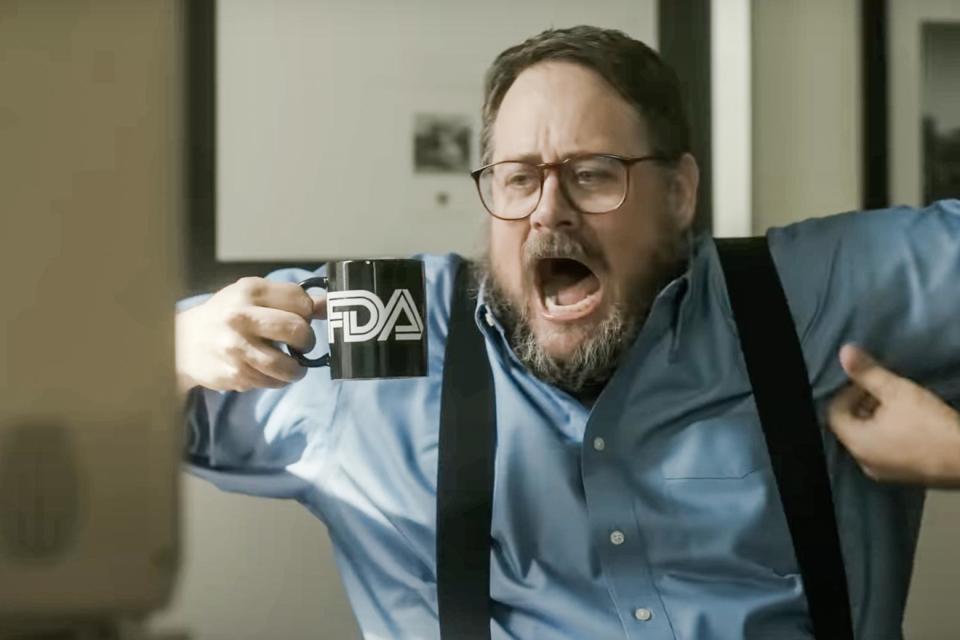What’s Fact and What’s Fiction in Painkiller , Netflix’s Hit Show About the Opioid Crisis

- Oops!Something went wrong.Please try again later.
- Oops!Something went wrong.Please try again later.
- Oops!Something went wrong.Please try again later.
Each episode of Netflix’s Painkiller, a six-part drama examining the Sackler family’s complicity in the creation and growth of the opioid epidemic, opens with the bereaved parent of a young person who overdosed on Purdue Pharma’s pain medication OxyContin. They deliver the standard disclaimer for fact-based drama (“certain characters, names, incidents, locations and dialogue have been fictionalized for dramatic purposes”) before reminding us in moving, yet dignified, terms that their deceased child is not a fictional construct. It is a gut punch of emotion, one that the drama that follows has trouble equaling.
The rise and fall of the Sacklers and their role in promoting OxyContin has already been the subject of one drama miniseries (Hulu’s Dopesick), a film memoir (Laura Poitras’ stirring All the Beauty and the Bloodshed), and a documentary, HBO’s excellent The Crime of the Century, made by Alex Gibney, who is an executive producer on Painkiller. In fact, Gibney had already optioned a 2017 New Yorker piece by Patrick Radden Keefe on the Sackler lawsuit to adapt as a narrative feature when he heard that Micah Fitzerman-Blue and Noah Harpster, who had written the Mr. Rogers biopic A Beautiful Day in the Neighborhood, were working on one based on the 2003 book Pain Killer by Barry Meier and proposed that, rather than develop competing projects, it would make more sense to work together.
Fitzerman-Blue and Harpster decided to focus on four figures in the narrative: Richard Sackler, Purdue Pharma’s CEO who is determined to stay unaccountable and in profit; tire shop owner, family man, and Oxy addict Glen Kryger (Taylor Kitsch, who previously worked with director Peter Berg on Friday Night Lights, where he played the troubled dreamboat high-school football player Tim Riggins); Shannon Schaeffer (West Duchovny), an ambitious Purdue sales rep who embarks on a modern Rake’s Progress from bright-eyed true believer in pain relief to disillusioned drug pusher; and Edie Flowers (Uzo Aduba), a dogged federal investigator. All but Sackler are composite characters, created for the purposes of this story.
Tasked with explaining to the high-powered law firm bringing civil suits against Purdue why the criminal investigation failed, Edie is stuck with the thankless task of narrating the story, and at times the show resembles an illustrated lecture, with the character reinforcing a point (e.g., “addiction hurts the whole family”) that a scene has just dramatized, in case we missed it. The result is an awkward mixture between a documentary’s desire to persuade by compellingly marshaling facts and a drama’s desire to elicit an emotional reaction. But the Edie character, whose brother is in jail for dealing crack, allows for the introduction of a much-needed parallel between the largely urban underclass crack cocaine epidemic, where mostly Black pushers were invariably locked up if caught with this illegal substance, and the largely rural, blue-collar “hillbilly heroin” OxyContin epidemic, where pushers were rewarded with entirely legitimate bonuses for selling large amounts of this FDA-approved drug. We look at where the show stays on the factual straight and narrow and where it veers off.

Matthew Broderick plays Robert Sackler as a sort of pharma version of Orson Welles’ Charles Foster Kane, rattling around his giant ersatz French chateau trying to ascertain why the fire alarms keep going off (the show is not big on metaphorical subtlety). A calculator made flesh, Sackler seems devoid of the ability to make an actual human connection but is devoted to his dog Unch, who accompanies him everywhere, even to the office. In fact, at one point, Sackler plays ball with a rambunctious Unch in a Purdue HQ corridor rather than meet with the Justice Department attorney investigating whether three of the company’s top executives lied to Congress.
This is largely factual. In his book Empire of Pain: The Secret History of the Sackler Dynasty, Keefe writes about how Sackler would bring Unch to the office and let him run free, as much an exercise of power as display of affection for his pet, since Unch’s liberty often made life difficult for employees who wouldn’t have been able to object. For example, Unch (a bulldog, not the mastiff the show depicts) had a tendency to leave calling cards on the purple carpet in the hallways of the executive floor, which visitors had to sidestep because Sackler could not be bothered to pick them up (or didn’t see why he should). The dog’s unusual name derived from the stock market abbreviation for “unchanged,” indicating a stock’s value had remained steady.

In the show, the DOJ attorney for the Western District of Virginia, John Brownlee (an actual person, not a fictional construct) in 2002 starts looking into whether Purdue pushed a product that the company knew to be addictive and hires Edie to help him. Their efforts are frustrated because, since OxyContin was an FDA-approved medication, no crime has been committed. Brownlee is finally able to bring criminal charges against the company and three top executives in 2007 after Edie discovers a doctor who has been sending warnings about the addictive nature of the drug to the company for years, which meant the executives lied (a felony) when they testified in front of Congress in 2001 that OxyContin’s addiction rate was less than 1 percent if the drug was used as prescribed. Furthermore, Edie discovers that the source Purdue relied on for this figure was not, as executives testified, a “landmark study,” but only a letter to the editor of the New England Journal of Medicine.
At first Richard Sackler resolutely refuses to settle, seeing it as a sign of weakness, only offering a one-off payment of $10 million to “Virginia law enforcement” and no apology. To defend the company against the criminal charges, Purdue hires Rudolph Giuliani as one of three powerhouse lawyers. Edie is looking forward to the case going to trial so the victims can finally get some justice, but on the day it is supposed to start, Purdue pleads guilty to one count of misbranding and settles. Part of the settlement is that the evidence Brownlee’s investigation has discovered will be buried. When Edie learns that her boss agreed to these terms because Giuliani called Congress, Congress called the DOJ, and the DOJ told Brownlee to cut a deal, she is so disgusted that she quits the DOJ.
In actuality, Purdue did indeed hire Giuliani, as much for his Washington connections as his legal expertise, complaining to the then-Deputy Attorney General James Comey (yes, the future FBI director) that Brownlee was exceeding his legal authority in pursuit of documents from the company.
Giuliani was not able to prevent Purdue’s conviction for fraudulent marketing claims about OxyContin’s safety, but, as part of the deal, he did secure an agreement that would make it difficult for the DOJ to prosecute the company in the future and ensured that senior executives would not serve prison time (to this day the Sacklers have never faced criminal charges relating to the opioid epidemic.) He also negotiated away a threatened prohibition on the federal government doing business with Purdue, a ban that would have greatly cut into the company’s profits. In return, Purdue pleaded guilty to a felony charge of misbranding and paid a federal fine of $635 million.
Brownlee defended the settlement, later saying he thought other agencies would use the felony conviction to look more closely at Purdue and OxyContin. But there was no follow-up. According to Keefe, Purdue, along with other companies in the painkiller sector, spent nearly $900 million on lobbying and political contributions between 2001 and 2015—eight times more than the gun lobby spent in the same period.

According to Edie’s account in the show, OxyContin’s path to FDA approval was a lot rockier than that of most drugs because, while several FDA inspectors would just nod an application through and take the company’s word for safety tests rather than have them reviewed by independent experts, Purdue had the misfortune to be assigned to Dr. Curtis Wright (played by series co-creator Noah Harpster), an FDA inspector who actually took his job seriously. As application after application gets turned down, by 1987 Richard’s father Raymond and uncle Mortimer are reminding him that if OxyContin doesn’t get approved in a timely fashion, the company will go bust because there’s nothing else in the pipeline. All three Sacklers go to see Wright and tell him that fewer than 0.3 percent of patients showed signs of abusing the drug. “But were you looking for signs of abuse?” Wright responds while pointing out how dangerous heroin in pill form is.
Undeterred, the Sacklers woo Wright with gifts like a new-fangled personal PC with camera attachment and boost his ego by arranging for him to co-publish a paper with their head of research and development, but nothing works. But then Wright meets with Purdue’s team in a hotel conference for three days and emerges ready to approve OxyContin’s use for chronic to moderate pain patients. “No one knows why,” Edie observes. Following OxyContin’s belated approval, she says, Wright left the FDA and shortly after that went to work for Purdue as a consultant.
This is true. Wright did join Purdue two years after leaving the FDA, with, according to Empire of Pain, a first-year compensation package of $400,000.
Similarly, U.S. Attorney for the District of Maine Jay McCloskey appears on television in February 2000, announcing that he has sent a letter to all of Maine’s practicing physicians warning them about the increasing abuse of OxyContin and other opiate-based prescription medications and the problems this is causing for law enforcement. But then, Edie recounts, McCloskey retired from his DOJ job in 2001, after which he was a paid consultant for Purdue until 2004.
This is true, and in fact McCloskey testified for the defense in the Sacklers’ 2007 trial.

The series shows fresh-faced graduate Shannon being recruited by the more sophisticated Purdue sales rep Britt with promises of helping the sick while making a lot of money. Britt not only gives her a makeover but invites Shannon to move into her fabulous bachelorette pad until the newbie can afford a place of her own. After going through the company sales training program-cum-cult indoctrination, Shannon is sent out to persuade doctors that OxyContin is less addictive than other opioids, with that addiction rate of less than 1 percent. She’s also told to come bearing gifts, whether muffins, branded merch, or Oxy coupons as she trots around to medical offices in the Fox News female-anchor uniform of skyscraper heels and tight, brightly colored dresses. Encouraged to flirt and flatter the largely middle-aged male doctors into placing orders for OxyContin—the higher the dosage the better—Shannon is soon moving into her own fabulous apartment and driving a new Porsche. But she begins to have doubts after some of the doctors expect more for their cooperation than gift muffins. Those doubts compound after another doctor calls her ”a drug dealer in a ponytail,” and even more after she sees teenagers crushing the pills and snorting them for the high.
We were unable to verify that young female Purdue sales reps were encouraged to wear sexy outfits and were propositioned—or worse—by client doctors, but Purdue was definitely known for its aggressive sales campaigns and financial incentives. The company patriarch, Arthur Sackler, was a doctor who put himself through medical school working as a copywriter, and his innovative marketing of Valium made it the top-selling drug of the ’70s and helped earn $2 billion for the drug’s developer, Hoffmann-La Roche. Purdue put a similar emphasis on marketing, spending $207 million on the launch of OxyContin and doubling its sales force to 600.
According to a National Institutes of Health report, the average salary for a sales rep in 2001 was $55,000, while bonuses ranged from $15,000 to nearly $240,000. That year, the company paid $40 million in sales incentive bonuses. Purdue charged insurance companies for OxyContin by the milligram, so the higher the dose prescribed, the more money the company made. This meant doctors with a high rate of high-dosage prescriptions were especially cultivated by sales reps.
Further evidence linking financial incentives to high-dose prescriptions was provided by a 2016 Los Angeles Times article, which gives examples like a West Virginia sales supervisor who sent one of his sales reps a letter in 1999 telling her she could earn a trip to Hawaii if she persuaded more doctors to write larger doses, or the Tennessee manager who sent his reps a memo in 1996 reminding them that raising dosage strength meant “$$$$$$$$$$$$$ It’s Bonus Time in the Neighborhood!”
Before OxyContin, doctors had been very circumspect about prescribing opium-based painkillers, reserving long-term use for cancer patients and end-of-life care. But Purdue promised all the efficacy of opioid relief with none of the danger of addiction, as long as patients only took it twice a day. The pills’ time-release coating meant, the sales reps were told, that pain relief would last for 12 hours (in fact, it wore off much sooner, meaning patients were faced with a choice between taking more pills than they should or suffering). OxyContin’s high price was based on this 12-hour duration, which gave it an advantage over less expensive painkillers that required more frequent dosages. In 2019, former sales reps came forward to recount that they were told to play down addiction risks during sales calls, dismissing withdrawal symptoms as the Purdue-invented term “pseudo-addiction.”

The show depicts a sales conference in Miami, where sales reps celebrate the company’s most profitable year yet, even as it’s being investigated. The happy partygoers, some of whom have been snorting the product, dance to an upbeat song extolling the drug’s wonders.
In reality, doctors were wooed with all sorts of branded promotional merch, including fishing hats, stuffed plush toys, souped-up Swiss Army knives, and CDs featuring tunes like “Get in the Swing With OxyContin,” as well as promotional brochures and slickly produced videos. One video, sent to some 15,000 doctors in 1998, featured patients testifying how OxyContin had helped them get their life back (the show depicts the fictional Greg being interviewed for the video) and concludes with a song titled “I Got My Life Back.” The entire video was formerly available on YouTube, but now only a truncated version of the video remains.

